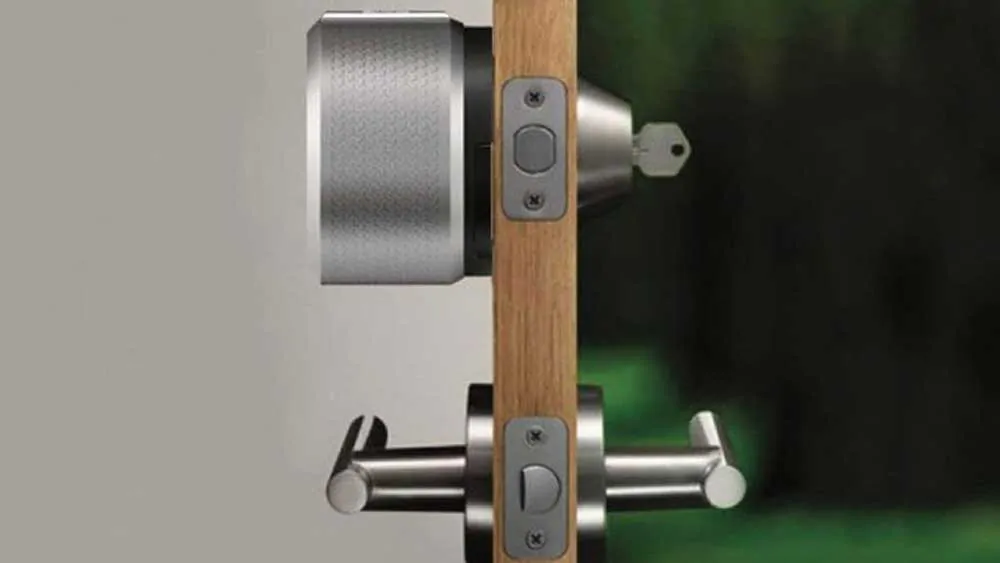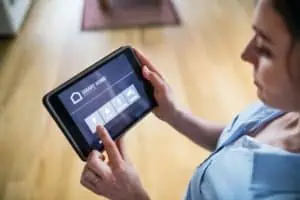Did you know you can install smart locks in your home and use a smartphone with Wi-Fi or Bluetooth connection to unlock your door? Sounds futuristic, right?
Smart locks have made this a reality. They liberate you from ever having to carry a key and allow you to lock and unlock your door with a touch of your finger or a voice command.
You can even gain or grant remote access from wherever you are, for example, letting you guest in while you are at work.
Smart locks are creating an advanced home security experience with customizable functionalities and features. The idea behind these devices is to give you control over your home security.
How Smart Locks Work?
A smart lock is an entirely new way to lock your doors. Once you have installed a smart lock and paired it with a smartphone via Bluetooth or Wi-Fi, you can lock or unlock it without a key.
There are several other locking and unlocking features depending on the make and model you use. You can wave or turn your smartphone facing the lock, tap an unlock button in an app, give a voice command as you approach the door, etc.
You can even program some smart locks to lock behind you automatically as you leave the house. Most smart locks offer one or more combinations of keyless locking/unlocking features. So choose one as per your preference.
Smart lock apps also allow you to share a virtual key with other family members, friends, visitors, and workers. However, the recipient will need to download the app on their smartphone. The best part is these virtual keys are valid for a specific timeframe.
One of the best security features of a smart lock is that the app sends you alerts whenever someone enters or leaves the house. This way, you can also keep a record of who entered and left the property and when.
In case your smart home system has a video doorbell, you can grant access to the visitors remotely by visually confirming their identity through a real-time video feed.
Main Features of a Smart Lock
It is clear by now that the smart locks go way beyond the functionalities of a traditional lock. However, here are some essential features you must look for when buying a smart lock.
- Smartphone app support
- Bluetooth connectivity
- Wi-Fi connectivity
- Feature to create temporary or permanent entry codes
- Multiple options for keyless entry
- Ability to limit or restrict access
- Auto-locking feature
- Geo-fencing or perimeter auto-locking (door locks automatically when the smartphone goes out of range)
- Receiving alerts on your smartphone
- Easy integration into your existing smart home solution
- Ability to sync with your video doorbell. (if you really need this one)
Installing a Smart Lock
A smart lock is a device designed to replace the traditional bolts on your front door. You will be happy to know that it is a DIY process easier than you may have expected and typically requires just a couple of screws. It will not take you more than an hour to install a smart lock all by yourself.
Promisingly, smart locks are not too expensive and cost almost as much as a premium standard key lock ranging between $200 and $300.
Smart locks operate on batteries that generally last from six months to a full year. When the battery is low, you will get an alert on your smartphone app to replace it.
Some of the smart locks by Yale come with external jacks, and you can hook up an external 9-volt battery in case the internal battery dies unexpectedly.
Are Smart Locks Safe?
More and more people are getting curious about smart homes and smart locks technology. Hence, there is a gradual increase in the rate of adoption of these devices by the customers.
According to Allied Market Research, there will be significant adoption of smart locks globally, especially among customers with jobs for whom the safety of their loved ones and family remains the top priority.
Smart locks and their enhanced features allow people to address safety and security issues via highly sophisticated monitoring remotely.
Are there any Safety Concerns?
You may wonder, smart locks might be convenient but are they hackable being a digital device? Or how safe or secure are they?
Yes, there is a possibility, but the criminals will need access to very sophisticated equipment or software to get in.
That said, we do not think anyone will go through all that hassle to break into a residence unless you have buried treasure under your roof.
Plus, manufacturers are continually responding to new threats by deploying security patches against newly discovered vulnerabilities in apps, associated cloud services, and firmware. Think of it precisely, like receiving an app update on your smartphone. Update the lock app, and you are good to go.
Things to Consider When Buying a Smart Lock
First and foremost, a smart lock is all about the convenience of use. So, you must consider how you would like to interact with your smart lock? Once you know the answer to that, it is easier to narrow down your options.
There is a huge variety of smart locks in terms of wireless technology, installation, and integration with smart home solutions and other third-party products such as video doorbell. However, they all roughly do the same thing; give you remote and advanced control over access to your space.
All smart locks operate on battery, but their lifespan may vary significantly. Typically, the more you use the smart lock, the quicker it will deplete the battery. Therefore, you must check with the manufacturer about the right battery type and ways to optimize the battery life.
Moreover, extreme weather, such as a colder temperature, may also affect battery life. However, do not let the battery power deter you from purchasing a smart lock of your choice. In fact, almost all smart locks now come with jumpstart nodes located at the lock’s bottom.
All you need is grab a 9V battery, connect it to the nodes, and give your battery enough juice to enter your virtual key code for unlocking.
Buy Wisely
Now that you know what smart locks are and how they can give you convenience and control over your home’s security, you can start looking for one.
However, always buy from reliable sources when buying online or directly from the manufacturer or manufacturer’s recommended electronics outlet.





